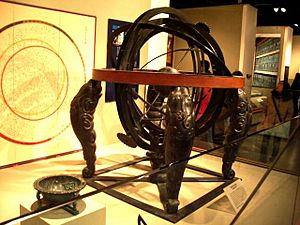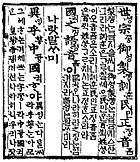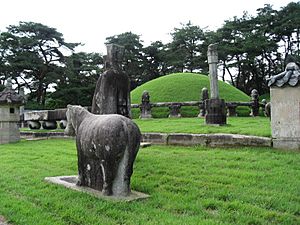Sejong the Great facts for kids
Quick facts for kids Sejong of Joseon朝鮮世宗 조선 세종 |
|||||||||
|---|---|---|---|---|---|---|---|---|---|
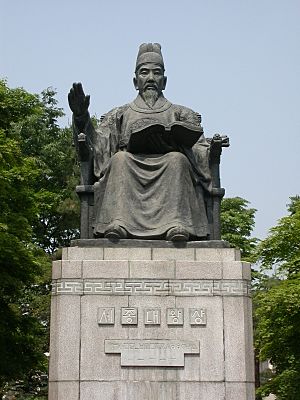
Bronze statue of Sejong the Great at Deoksu Palace
|
|||||||||
| King of Joseon | |||||||||
| Reign | 19 September 1418 – 8 April 1450 | ||||||||
| Coronation | Geunjeongjeon Hall, Gyeongbok Palace, Hanseong, Kingdom of Joseon | ||||||||
| Predecessor | Taejong of Joseon | ||||||||
| Successor | Munjong of Joseon | ||||||||
| Regent |
|
||||||||
| Crown Prince of Joseon | |||||||||
| Tenure | 15 July 1418 – 19 September 1418 | ||||||||
| Predecessor | Crown Prince Yi Je | ||||||||
| Successor | Crown Prince Yi Hyang | ||||||||
| Born | Yi Do (이도, 李祹) 15 May 1397 Main Palace, Hanseong, Kingdom of Joseon |
||||||||
| Died | 8 April 1450 (aged 52) Grand Prince Yeongeung's private residence, Hanseong, Kingdom of Joseon |
||||||||
| Burial | Yeongneung Tombs, Yeoju, Gyeonggi Province, South Korea | ||||||||
| Spouse |
Queen Soheon
(m. 1408; died 1446) |
||||||||
| Issue | Munjong of Joseon Sejo of Joseon |
||||||||
|
|||||||||
| Clan | Jeonju Yi clan | ||||||||
| Dynasty | House of Yi | ||||||||
| Father | Taejong of Joseon | ||||||||
| Mother | Queen Wongyeong | ||||||||
| Religion | Korean Confucianism (Neo-Confucianism) → Korean Buddhism | ||||||||
| Korean name | |
| Hangul | |
|---|---|
| Hanja | |
| Revised Romanization | Sejong |
| McCune–Reischauer | Sechong |
| Birth name | |
| Hangul | |
| Hanja | |
| Revised Romanization | I Do |
| McCune–Reischauer | Yi To |
| Childhood name | |
| Hangul | |
| Hanja | |
| Revised Romanization | Makdong |
| McCune–Reischauer | Maktong |
| Courtesy name | |
| Hangul | |
| Hanja | |
| Revised Romanization | Wonjeong |
| McCune–Reischauer | Wŏnjŏng |
Sejong of Joseon (born May 15, 1397 – died April 8, 1450) was the fourth king of the Joseon dynasty in Korea. His personal name was Yi Do. He is widely known as Sejong the Great because of his many achievements.
Sejong was the third son of King Taejong and Queen Wongyeong. In 1418, he became the heir after his older brother, Crown Prince Yi Je, lost his position. Today, King Sejong is seen as one of the most important leaders in Korean history.
He became king when his father stepped down in 1418. However, his father, Taejong, still held the real power until he died in 1422. Sejong then ruled alone for 28 years. After 1439, he became very ill. From 1442, his oldest son, Crown Prince Yi Hyang (who would become King Munjong), helped him rule.
Sejong strengthened Confucian ideas in the government. He also made big changes to the laws. He created and introduced the Korean alphabet called hangul. He also supported new ideas in science and technology. He helped the economy grow. He sent armies north and started a plan to move people to those areas. In the south, he fought against Japanese pirates.
Who Was Sejong?
The title "the Great" (대왕, 大王) was given to many kings after they died. But it is most often used for Gwanggaeto and Sejong. This shows how important they were.
Sejong's Early Life
Sejong was born on April 10, 1397. This date was later changed to May 15, which is now his official birthday. In South Korea, this day is celebrated along with National Teachers Day.
He was the son of King Taejong and Queen Wongyeong. When he was twelve, he became Grand Prince Chungnyeong. His father liked him more than his two older brothers.
It was unusual for a third son to become king. King Taejong's oldest son, Yi Je, was named heir in 1404. But he enjoyed hunting and leisure too much. So, he was removed from his position in June 1418. Some say he gave up his right to the throne for Sejong. Taejong's second son became a Buddhist monk.
After Yi Je was removed, Taejong quickly made his third son the new heir. He also removed officials who did not agree with this change. In September 1418, Taejong stepped down as king. But he still had a lot of power in the government. Sejong's true skills as a leader became clear after his father died in 1422.
How Sejong Ruled Korea
King Sejong made many changes to how the country was run. He chose people from different social classes to work in the government. He also made sure that government ceremonies followed Confucianism and encouraged people to live by its teachings.
Religion in Joseon
Sejong reduced the power of Buddhism. He stopped monks from outside the capital, Hanseong, from entering. He also cut down the number of Buddhist schools from seven to two. This greatly reduced the wealth and power of religious leaders.
Sejong also changed the land system. Temple lands were taken and used for other purposes. This made monks lose a lot of their economic power. During the Goryeo dynasty, monks had a lot of influence in politics and money. But in Joseon, most powerful people followed Confucianism. They saw Buddhism as a wrong way of thinking.
In 1427, Sejong also made a rule against the Huihui (Korean Muslim) community. They had special status and payments since the Yuan dynasty ruled Goryeo. The Huihui were forced to change their clothing and close their "ceremonial hall" (a mosque in Gaegyeong). They had to worship like everyone else. After this, there is no more mention of Muslims in the Joseon era.
Boosting the Economy
In the early Joseon dynasty, people mostly traded goods instead of using money. Cloth, grain, and cotton were common forms of payment. In 1423, King Sejong tried to create a national currency. It was based on the Kaiyuan Tongbao coin from the Tang dynasty in China.
The new coin was called the Joseon Tongbo. It was made of bronze and was worth a certain amount of silver. But making these coins was too expensive. So, their production stopped in 1425.
Foreign Relations
Sejong worked closely with China's Ming dynasty. He also set up ten military posts in the northern part of the peninsula. These posts helped control the Jurchen people.
He opened three ports for trade with Japan. But he also sent armies to stop Japanese pirates in the East China Sea. These pirates were causing problems for Korea.
Military Strength
King Sejong was a very good military planner. He made new rules to keep his kingdom safe. He also supported new ideas in military technology. This included making better cannons. Different types of mortars and fire arrows were tested. They also used gunpowder in new ways.
In June 1419, Sejong started the Ōei Invasion. His father, Taejong, advised him on this. The main goal was to stop Japanese pirates who were active near Tsushima Island. During this invasion, many Japanese were killed or captured. Korean soldiers also died. More than 150 kidnapped people (Chinese and Koreans) were freed.
A truce was made in July 1419. The Joseon army went back to Korea. But a formal agreement was not signed until 1443. This agreement was called the Treaty of Gyehae. In it, the leader of Tsushima promised to pay tribute to the king of Joseon. In return, the Joseon court gave the Sō clan special trading rights.
In 1433, Sejong sent Gim Jong-seo, a famous general, to the north. His mission was to defeat the Jurchens. Gim's army captured several forts and expanded Korean land north to the Songhua River. Four counties and six military areas were set up to protect the people from the Jurchens.
Advancements in Science and Technology
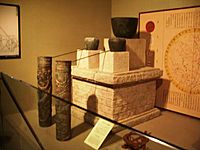
In 1420, King Sejong created a special place for science at Gyeongbok Palace. It was called the Hall of Worthies (Jiphyeonjeon). This institute was for scientific research to improve the country's technology. The Hall of Worthies brought together the smartest thinkers in Joseon. The government gave them money and scholarships to encourage young scholars.
Sejong greatly supported the sciences. He wanted to help farmers. So, he decided to create a farmer's handbook. This book, called Nongsa Jikseol, had information about farming techniques. Scientists gathered these methods from different parts of Korea. These techniques were important for new ways of farming that were being used.
One of Sejong's close friends was the inventor Jang Yeong-sil. Jang was a very creative and smart person. Sejong noticed his talent and invited him to his court in Hanseong. When Sejong gave Jang a government job and money for his inventions, some officials protested. They thought someone from a lower class should not have power among nobles. But Sejong believed Jang deserved support because of his skills.
Jang Yeong-sil created new designs for water clocks, armillary spheres (models of the sky), and sundials.
In 1442, Jang Yeong-sil made one of the world's first standard rain gauges, called Cheugugi. The original model no longer exists. The oldest one we have was made in 1770. King Yeongjo wanted to bring back the great times of King Sejong. He read old records and found mention of a rain gauge. So, he ordered one to be made again.
In 1434, Jang Yeong-sil also invented the Gabinja. This was a new type of printing press. It was said to be twice as fast as older models. It was made from copper-zinc and lead-tin metals.
Sejong also wanted to improve the Korean calendar system. At that time, it was based on the longitude of the Chinese capital. He had his astronomers create a calendar using Hanseong, the Joseon capital, as the main point. This new system helped Joseon astronomers correctly predict when solar and lunar eclipses would happen.
In traditional Korean medicine, two important books were written during his rule. These were the Hyangyak Jipseongbang and the Euibang Yuchwi. These books show that Koreans tried to create their own medical knowledge, separate from China's.
Public Welfare and Fairness
In 1426, Sejong made a law that gave government nobi (slave) women 100 days of maternity leave after giving birth. In 1430, this was extended to include one month before childbirth. In 1434, he also gave husbands 30 days of paternity leave.
To make taxes fair for everyone, Sejong ordered a nationwide survey in 1430. This was about a new tax system called Gongbeop. For five months, 172,806 people were asked their opinion. About 57% of them approved the new tax plan.
Joseon's economy relied on farmers. So, Sejong allowed them to pay more or less tax depending on how good or bad the harvest was. This meant farmers could worry less about taxes and focus on their crops. It is said that once, when the palace had extra food, the king gave it to poor farmers who needed it.
Literature and Arts
In 1429, the book Nongsa Jikseol ("Explanations of Agriculture") was put together. It was the first book about Korean farming. It covered topics like planting, harvesting, and soil care.
Sejong was also a writer himself. He wrote the famous Yongbieocheonga ("Songs of Flying Dragons") in 1445. He also wrote Seokbo Sangjeol ("Episodes from the Life of Buddha") and Worin Cheongang Jigok ("Songs of the Moon Shining on a Thousand Rivers") in 1447. Another work was Dongguk Jeongun ("Dictionary of Proper Sino-Korean Pronunciation") in 1447.
One of Sejong’s close friends was the musician Park Yeon. Together, they created over two hundred musical pieces. Sejong’s own music includes Chongdaeop ("Great Achievements") and Potaepyeong ("Preservation of Peace"). These are played during the Jongmyo Jerye (memorials for Joseon kings). His piece Yominrak ("A Joy to Share with the People") is still played by traditional Korean orchestras today.
In 1418, scholars during Sejong's rule developed the Pyeongyeong. This was a lithophone, a musical instrument made of stone slabs. It was based on a Chinese instrument. The Pyeongyeong has two rows of 8 stone slabs. It has a 16-tone range and is played with an ox horn mallet. It was used mainly for ceremonies.
The Creation of Hangul
King Sejong made a huge impact on Korea's history by creating hangul. This is the native writing system for the Korean language. Many people think he ordered the Hall of Worthies to invent it. But old records show that Sejong invented it himself.
Before hangul, Koreans mostly wrote using Classical Chinese. There were also other writing systems based on Chinese characters. But Korean and Chinese languages are very different. Also, there were many characters to learn. So, common people, who often did not get much education, found it very hard to learn to write.
To solve this problem, King Sejong created this unique alphabet. It had 28 letters when it was first made, but four of them are not used anymore. He wanted to help everyone learn to read and write. Each consonant letter is based on a simple drawing of how the mouth, tongue, and teeth move when making the sound. Vowels were made from dots and lines that stood for heaven, earth, and humanity. Words are built by putting letters together in blocks for each syllable. These blocks are then written in a line.
Hangul was finished in 1443 and published in 1446. It came with a 33-page manual called Hunminjeongeum. This manual explained what the letters were and the ideas behind them. It said that anyone could learn the alphabet in just a few days. People who have never seen it before can usually say Korean words correctly after only a few hours of study.
King Sejong faced opposition from the noble class. Many did not like the idea of a writing system for common people. Some thought that if peasants could read and write, they might find ways to get around the law. Others felt that hangul would threaten their families' positions in court. This was because it would create more people who could become civil servants.
The Joseon elite kept using Chinese characters long after Sejong died. Hangul was often looked down upon by those in power. They gave it nicknames like eonmun ("vulgar script") or amkeul ("women’s script"). Despite this, the system became popular among women and writers of fiction.
In 1504, the study and publishing of hangul were banned by Yeonsangun. But it still spread and survived. This was thanks to books published for women, its use by Buddhist monks, and the arrival of Christianity in Korea in 1602. Hangul became more common in the 16th century because of a rise in literature and poetry. It continued to grow in popularity in the 17th century. It was used even more after a period of nationalism in the 19th century. In 1849, it became Korea’s national writing system. It was first used in official government documents. After the Treaty of 1910, hangul was banned again until Korea became free in 1945.
Sejong's Later Years and Death
Sejong became blind due to problems from diabetes. These health issues eventually led to his death in 1450. He was buried at Yeongneung (영릉, 英陵). He was buried in the same mound as his wife, Queen Soheon, who had died four years earlier. His tomb is in Yeoju, Gyeonggi Province, South Korea.
His first son, Yi Hyang (later King Munjong), became the next king. Sejong thought that Munjong, who was often sick, might not live long. On his deathbed, Sejong asked the scholars from the Hall of Worthies to look after his young grandson, Danjong. As Sejong expected, Munjong died two years after becoming king. The country's stability ended when Danjong became king at age twelve.
Eventually, Sejong's second son, Grand Prince Suyang (later King Sejo), took the throne in 1455. When some court officials tried to help his nephew Danjong get the throne back, Sejo closed the Hall of Worthies. He also had Danjong and several ministers from Sejong's time killed.
Sejong's Family
- Father: King Taejong of Joseon (1367 – 1422)
- Mother: Queen Wongyeong of the Yeoheung Min clan (1365 – 1420)
Wives and Children:
- Queen Soheon of the Cheongsong Shim clan (1395 – 1446)
- Princess Jeongso (1412 – 1424)
- Crown Prince Yi Hyang (1414 – 1452)
- Princess Jeongui (1415 – 1477)
- Yi Yu, Grand Prince Suyang (1417 – 1468)
- Yi Yong, Grand Prince Anpyeong (1418 – 1453)
- Yi Gu, Grand Prince Imyeong (1420 – 1469)
- Yi Yeo, Grand Prince Gwangpyeong (1425 – 1444)
- Yi Yu, Grand Prince Geumseong (1426 – 1457)
- Yi Im, Grand Prince Pyeongwon (1427 – 1445)
- Yi Yeom, Grand Prince Yeongeung (1434 – 1467)
- Royal Noble Consort Yeong of the Jinju Gang clan
- Yi Yeong, Prince Hwaui (1425 – 1460)
- Royal Noble Consort Shin of the Cheongju Gim clan (1406 – 1464)
- Yi Jeung, Prince Gyeyang (1427 – 1464)
- Yi Gong, Prince Uichang (1428 – 1460)
- Yi Chim, Prince Milseong (1430 – 1479)
- Yi Yeon, Prince Ikhyeon (1431 – 1463)
- Yi Dang, Prince Yeonghae (1435 – 1477)
- Yi Geo, Prince Damyang (1439 – 1450)
- Royal Noble Consort Hye of the Cheongju Yang clan (? – 1455)
- Yi Eo, Prince Hannam (1429 – 1459)
- Yi Hyeon, Prince Suchun (1431 – 1455)
- Yi Jeon, Prince Yeongpung (1434 – 1456)
- Royal Consort Gwi-in of the Miryang Park clan
- Royal Consort Gwi-in of the Jeonju Choe clan
- Royal Consort Sug-ui of the Jo clan
- Royal Consort Sug-yong of the Hong clan (? – 1452)
- Royal Consort Sug-won of the Yi clan
- Princess Jeongan (1438 – 1461)
- Court Lady Song (1396 – 1463)
- Princess Jeonghyeon (1425 – 1480)
- Court Lady Cha (? – 1444)
Sejong's Legacy
King Sejong is remembered for many great things. His statue and name are found in many places in Korea.
Statue and Museum
In 2009, a 9.5-meter-high bronze statue of King Sejong was put in Gwanghwamun Square in Seoul. It is right in front of the Sejong Center for the Performing Arts. The sculptor was Kim Young-won.
Underneath the statue is an entrance to an underground museum. It is called "The Story of King Sejong." The statue was revealed on Hangul Day. This was to celebrate the 563rd anniversary of the Korean alphabet's invention.
Places Named After Sejong
Sejong Street (세종로, 世宗路) and the Sejong Centre for the Performing Arts are both in central Seoul. They are named after King Sejong.
In 2007, the government of South Korea decided to create a special city. It was made from a part of the South Chungcheong Province, near Daejeon. This new city was named "Sejong Special Autonomous City".
Sejong on Korean Money

A picture of Sejong is on the 10,000 won banknote of the South Korean won. The banknote also shows different scientific tools that were invented during his rule.
See also
 In Spanish: Sejong el Grande para niños
In Spanish: Sejong el Grande para niños
- King Sejong Institute
- King Sejong Station
- Sejong Center
- Sejong City
- Sejong the Great-class destroyer
- Sejongno
- UNESCO King Sejong Literacy Prize
- Hunminjeongeum
- Hangul


